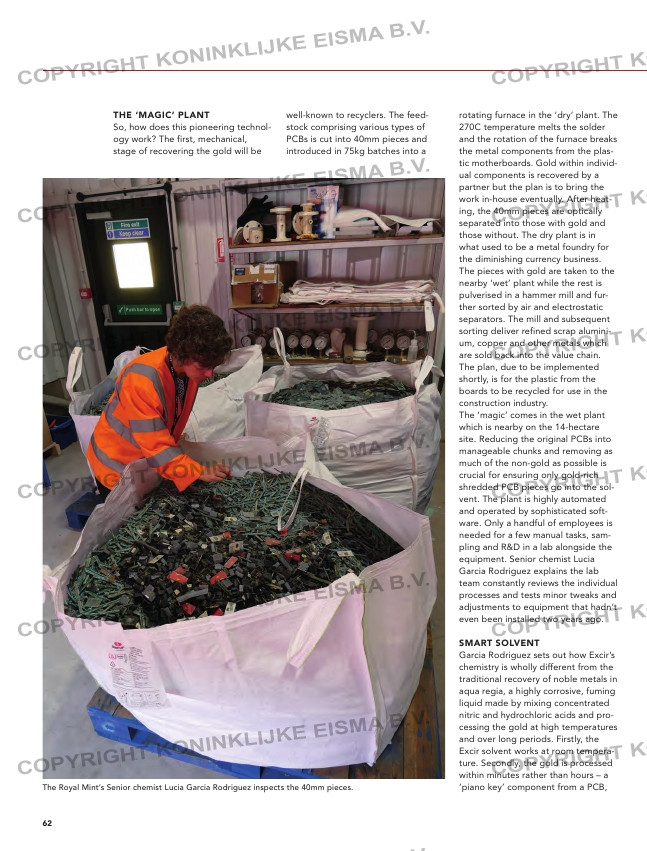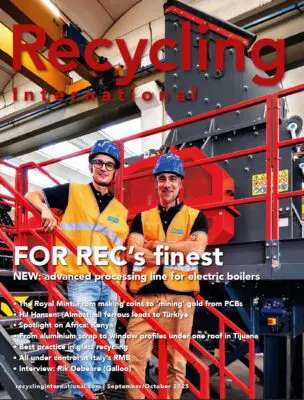Page 70 from: Recycling International September/October 2025

62
THE ‘MAGIC’ PLANT
So, how does this pioneering technol-
ogy work? The first, mechanical,
stage of recovering the gold will be
well-known to recyclers. The feed-
stock comprising various types of
PCBs is cut into 40mm pieces and
introduced in 75kg batches into a
rotating furnace in the ‘dry’ plant. The
270C temperature melts the solder
and the rotation of the furnace breaks
the metal components from the plas-
tic motherboards. Gold within individ-
ual components is recovered by a
partner but the plan is to bring the
work in-house eventually. After heat-
ing, the 40mm pieces are optically
separated into those with gold and
those without. The dry plant is in
what used to be a metal foundry for
the diminishing currency business.
The pieces with gold are taken to the
nearby ‘wet’ plant while the rest is
pulverised in a hammer mill and fur-
ther sorted by air and electrostatic
separators. The mill and subsequent
sorting deliver refined scrap alumini-
um, copper and other metals which
are sold back into the value chain.
The plan, due to be implemented
shortly, is for the plastic from the
boards to be recycled for use in the
construction industry.
The ‘magic’ comes in the wet plant
which is nearby on the 14-hectare
site. Reducing the original PCBs into
manageable chunks and removing as
much of the non-gold as possible is
crucial for ensuring only gold-rich
shredded PCB pieces go into the sol-
vent. The plant is highly automated
and operated by sophisticated soft-
ware. Only a handful of employees is
needed for a few manual tasks, sam-
pling and R&D in a lab alongside the
equipment. Senior chemist Lucia
Garcia Rodriguez explains the lab
team constantly reviews the individual
processes and tests minor tweaks and
adjustments to equipment that hadn’t
even been installed two years ago.
SMART SOLVENT
Garcia Rodriguez sets out how Excir’s
chemistry is wholly different from the
traditional recovery of noble metals in
aqua regia, a highly corrosive, fuming
liquid made by mixing concentrated
nitric and hydrochloric acids and pro-
cessing the gold at high temperatures
and over long periods. Firstly, the
Excir solvent works at room tempera-
ture. Secondly, the gold is processed
within minutes rather than hours – a
‘piano key’ component from a PCB,
for example, is stripped of gold with-
in four minutes. Thirdly, the solvent is
reusable with up to 80% returned for
subsequent leaching. Fourthly, the
gases given off are isolated and treat-
ed to make a salt.
Because gold is so heavy, gravity
plays a big part in moving it through
the solvent process. The oxidised
gold solution is then filtered, washed
and dried before gold is precipitated
back as a powder. The chemistry was
always intended to target gold but
Royal Mint is now working with Excir
to see how the chemistry could be
modified to selectively target other
potentially high value metals such as
silver or palladium.
SUSTAINABILITY ‘CRUCIAL’
John and Doak are adamant that sus-
tainability is crucial to the business
plan, even though it’s clear the profit-
ability of recycling gold far exceeds
the returns on other materials. The
latter – whose role covers the entire
operations of The Royal Mint – insists
there are two reasons it wants to
obtain value from everything.
‘Firstly, we couldn’t talk about a sus-
tainable solution or a circular econo-
my if we were literally just taking the
gold. Secondly, there is still value in
the other componentry of the printed
circuit boards, whether it’s the metal
or the non-metal components. Some
we will make a profit on, others we
may just cover costs.’
John says the availability of feedstock
has met expectations and there is the
certainty of a growing mountain of
e-scrap in both business and ‘hoard-
ed’ within households. But less than
20% of e-scrap is currently recycled
world-wide and an estimated 7% of
the world’s gold, along with other
usable metals and materials, is locked
away in unwanted phones, PCs etc.
‘The future of the waste pipeline may
be unknown but, globally, e-waste is
increasing year-on-year.’
‘KEEP IT AT HOME’
John believes more of the scrap
should be retained in the UK.
‘Something like 97% of e-scrap leaves
the country. Every day, copper or rare The Royal Mint’s Senior chemist Lucia Garcia Rodriguez inspects the 40mm pieces.
60-61-62-63-64-65_theroyalmint.indd 62 09-09-2025 13:28



